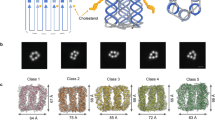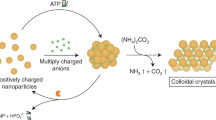Abstract
Self-assembly of nanoparticles at fluid interfaces has emerged as a simple yet efficient way to create two-dimensional membranes with tunable properties1,2,3,4,5,6. In these membranes, inorganic nanoparticles are coated with a shell of organic ligands that interlock as spacers and provide tensile strength. Although curvature due to gradients in lipid-bilayer composition and protein scaffolding7,8 is a key feature of many biological membranes, creating gradients in nanoparticle membranes has been difficult. Here, we show by X-ray scattering that nanoparticle membranes formed at air/water interfaces exhibit a small but significant ∼6 Å difference in average ligand-shell thickness between their two sides. This affects surface-enhanced Raman scattering and can be used to fold detached free-standing membranes into tubes by exposure to electron beams. Molecular dynamics simulations elucidate the roles of ligand coverage and mobility in producing and maintaining this asymmetry. Understanding this Janus-like membrane asymmetry opens up new avenues for designing nanoparticle superstructures.
This is a preview of subscription content, access via your institution
Access options
Subscribe to this journal
Receive 12 print issues and online access
$259.00 per year
only $21.58 per issue
Buy this article
- Purchase on Springer Link
- Instant access to full article PDF
Prices may be subject to local taxes which are calculated during checkout




Similar content being viewed by others
References
McGorty, R., Fung, J., Kaz, D. & Manoharan, V. N. Colloidal self-assembly at an interface. Mater. Today 13, 34–42 (June, 2010).
Bresme, F. & Oettel, M. Nanoparticles at fluid interfaces. J. Phys. Condens. Matter 19, 413101–413133 (2007).
Lin, Y., Skaff, H., Emrick, T., Dinsmore, A. D. & Russell, T. P. Nanoparticle assembly and transport at liquid–liquid interfaces. Science 299, 226–229 (2003).
Boker, A., He, J., Emrick, T. & Russell, T. P. Self-assembly of nanoparticles at interfaces. Soft Matter 3, 1231–1248 (2007).
Cheng, W. et al. Free-standing nanoparticle superlattice sheets controlled by DNA. Nature Mater. 8, 519–525 (2009).
Dong, A., Chen, J., Vora, P. M., Kikkawa, J. M. & Murray, C. B. Binary nanocrystal superlattice membranes self-assembled at the liquid–air interface. Nature 466, 474–477 (2010).
Zimmerberg, J. & Kozlov, M. M. How proteins produce cellular membrane curvature. Nature Rev. Mol. Cell Biol. 7, 9–19 (2006).
McMahon, H. T. & Gallop, J. L. Membrane curvature and mechanisms of dynamic cell membrane remodelling. Nature 438, 590–596 (2005).
Mueggenburg, K. E., Lin, X. M., Goldsmith, R. H. & Jaeger, H. M. Elastic membranes of close-packed nanoparticle arrays. Nature Mater. 6, 656–660 (2007).
He, J. B. et al. Fabrication and mechanical properties of large-scale freestanding nanoparticle membranes. Small 6, 1449–1456 (2010).
Lin, Y. et al. Ultrathin cross-linked nanoparticle membranes. J. Am. Chem. Soc. 125, 12690–12691 (2003).
Hill, W. & Wehling, B. Potential-dependent and Ph-dependent surface-enhanced Raman-scattering of p-mercaptoaniline on silver and gold substrates. J. Phys. Chem. 97, 9451–9455 (1993).
Liu, G. K. et al. Laser-induced formation of metal–molecule–metal junctions between Au nanoparticles as probed by surface-enhanced Raman spectroscopy. J. Phys. Chem. C 112, 6499–6508 (2008).
Narayanan, S., Wang, J. & Lin, X. M. Dynamical self-assembly of nanocrystal superlattices during colloidal droplet evaporation by in situ small angle x-ray scattering. Phys. Rev. Lett. 93, 135503 (2004).
Vegso, K. et al. Silver nanoparticle monolayer-to-bilayer transition at the air/water interface as studied by the GISAXS technique: Application of a new paracrystal model. Langmuir 28, 9395–9404 (2012).
Smith, D. K., Goodfellow, B., Smilgies, D. M. & Korgel, B. A. Self-assembled simple hexagonal AB(2) binary nanocrystal superlattices: SEM, GISAXS, and defects. J. Am. Chem. Soc. 131, 3281–3290 (2009).
Pietra, F. et al. Semiconductor nanorod self-assembly at the liquid/air interface studied by in situ GISAXS and ex situ TEM. Nano Lett. 12, 5515–5523 (2012).
Jiang, Z., Lin, X. M., Sprung, M., Narayanan, S. & Wang, J. Capturing the crystalline phase of two-dimensional nanocrystal superlattices in action. Nano Lett. 10, 799–803 (2010).
Jiang, Z., Lee, D. R., Narayanan, S., Wang, J. & Sinha, S. K. Waveguide-enhanced grazing-incidence small-angle x-ray scattering of buried nanostructures in thin films. Phys. Rev. B 84, 075440 (2011).
McCarley, R. L., Dunaway, D. J. & Willicut, R. J. Mobility of the alkanethiol-gold (111) interface studied by scanning probe microscopy. Langmuir 9, 2775–2777 (1993).
Norgaard, K., Weygand, M. J., Kjaer, K., Brust, M. & Bjornholm, T. Adaptive chemistry of bifunctional gold nanoparticles at the air/water interface. A synchrotron X-ray study of giant amphiphiles. Faraday Discuss. 125, 221–233 (2004).
Glogowski, E., He, J. B., Russell, T. P. & Emrick, T. Mixed monolayer coverage on gold nanoparticles for interfacial stabilization of immiscible fluids. Chem. Commun. 32, 4050–4052 (2005).
Pensa, E. et al. The chemistry of the sulfur–gold interface: In search of a unified model. Acc. Chem. Res. 45, 1183–1192 (2012).
Tay, K. A. & Bresme, F. Wetting properties of passivated metal nanocrystals at liquid–vapor interfaces: A computer simulation study. J. Am. Chem. Soc. 128, 14166–14175 (2006).
Lane, J. M. D. & Grest, G. S. Spontaneous asymmetry of coated spherical nanoparticles in solution and at liquid–vapor interfaces. Phys. Rev. Lett. 104, 235501 (2010).
Freund, L. B. & Suresh, S. Thin Film Materials: Stress, Defect Formation and Surface Evolution (Cambridge Univ. Press, 2003).
Schmidt, Q. G. & Eberl, K. Thin solid films roll up into nanotubes. Nature 410, 168 (2001).
Tadaki, T., Otsuka, K. & Shimizu, K. Shape memory alloys. Annu. Rev. Mater. Sci. 18, 25–45 (1988).
Deserno, M. Fluid lipid membranes: From differential geometry to curvature stresses. Chem. Phys. Lipids 185, 11–45 (2015).
Kanjanaboos, P., Joshi-Imre, A., Lin, X. M. & Jaeger, H. M. Strain patterning and direct measurement of Poisson’s ratio in nanoparticle mono layer sheets. Nano Lett. 11, 2567–2571 (2011).
Scheffer, L., Bitler, A., Ben-Jacob, E. & Korenstein, R. Atomic force pulling: Probing the local elasticity of the cell membrane. Eur. Biophys. J. 30, 83–90 (2001).
Blees, M., Rose, P., Barnard, A., Roberts, S. & McEuen, P. L. American Physical Society March Meeting (2014); http://meetings.aps.org/link/BAPS.2014.MAR.L30.11
Zharnikov, M. & Grunze, M. Modification of thiol-derived self-assembling monolayers by electron and X-ray irradiation: Scientific and lithographic aspects. J. Vac. Sci. Technol. B 20, 1793–1807 (2002).
Zhou, C., Trionfi, A., Hsu, J. W. P. & Walker, A. V. Electron-beam-induced damage of alkanethiolate self-assembled monolayers (SAMs): Dependence on monolayer structure and substrate conductivity. J. Phys. Chem. C 114, 9362–9369 (2010).
Marrink, S. J., Risselada, H. J., Yefimov, S., Tieleman, D. P. & de Vries, A. H. The MARTINI force field: Coarse grained model for biomolecular simulations. J. Phys. Chem. B 111, 7812–7824 (2007).
Acknowledgements
The authors thank S. McBride and E. Barry for many stimulating discussions. We also benefited from discussions with Y. Rabin of Ilan University, Israel, and R. Salvarezza of INIFTA, Argentina. This work was performed at the Center of Nanoscale Materials and 8-ID at the Advanced Photon Source, a US Department of Energy, Office of Science, Office of Basic Energy Sciences User Facility under Contract No. DE-AC02-06CH11357. The work at the University of Chicago was supported by the NSF through grant DMR-1207204 and through the Chicago MRSEC, under NSF DMR-1420709. This research used resources of the National Energy Research Scientific Computing Center, a DOE Office of Science User Facility supported by the Office of Science of the US Department of Energy under Contract No. DE-AC02-05CH11231. This research also used resources of the Argonne Leadership Computing Facility, which is a DOE Office of Science User Facility supported under Contract DE-AC02-06CH11357.
Author information
Authors and Affiliations
Contributions
Z.J., J.H. and X-M.L. performed the GISAXS experiments and Z.J. and J.W. analysed the data. P.K., Y.W. and X-M.L. carried out the SEM study of the membrane-folding experiment. J.H. performed the Raman study of the monolayer. X-M.L. synthesized the nanoparticles used. S.K.R.S.S. guided the simulation effort. S.A.D., G.K. and S.K.R.S.S. performed and analysed the coarse-grained molecular dynamics simulation. J.W., H.M.J. and X-M.L. conceived the project and designed the experiments. All authors contributed to the preparation of the manuscript.
Corresponding author
Ethics declarations
Competing interests
The authors declare no competing financial interests.
Supplementary information
Supplementary Information
Supplementary Information (PDF 2479 kb)
Rights and permissions
About this article
Cite this article
Jiang, Z., He, J., Deshmukh, S. et al. Subnanometre ligand-shell asymmetry leads to Janus-like nanoparticle membranes. Nature Mater 14, 912–917 (2015). https://doi.org/10.1038/nmat4321
Received:
Accepted:
Published:
Issue Date:
DOI: https://doi.org/10.1038/nmat4321
This article is cited by
-
Martini 3: a general purpose force field for coarse-grained molecular dynamics
Nature Methods (2021)
-
Mechanical Properties of Architected Nanomaterials Made from Organic–Inorganic Nanocrystals
JOM (2018)
-
High-temperature crystallization of nanocrystals into three-dimensional superlattices
Nature (2017)



